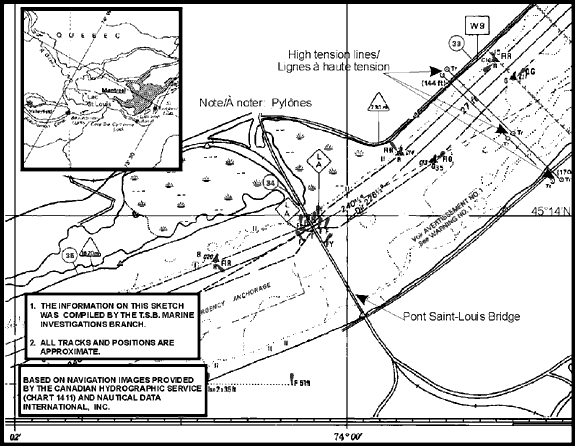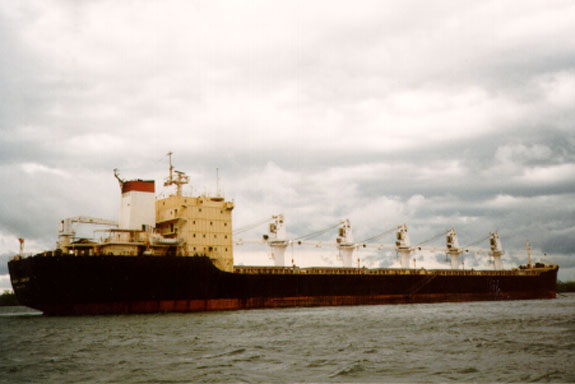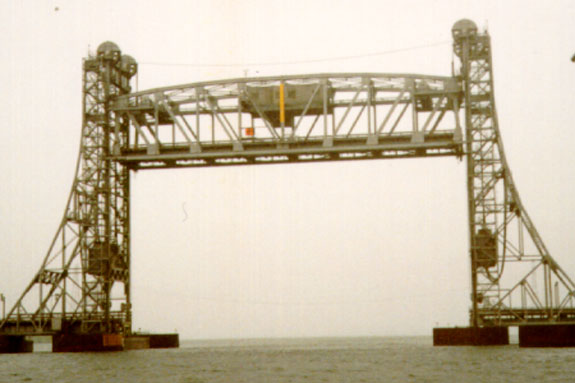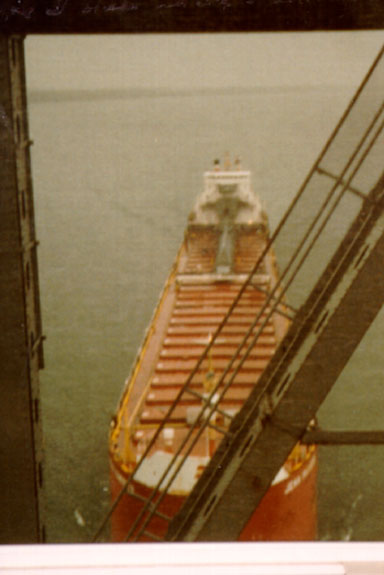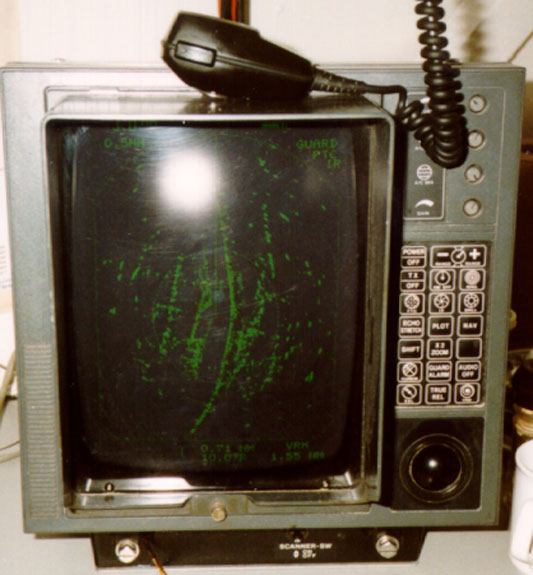Bottom contact
bulk carrier "GRANT CARRIER"
near the Saint-Louis bridge on the
St. Lawrence Seaway, Quebec
The Transportation Safety Board of Canada (TSB) investigated this occurrence for the purpose of advancing transportation safety. It is not the function of the Board to assign fault or determine civil or criminal liability. This report is not created for use in the context of legal, disciplinary or other proceedings. See Ownership and use of content. Masculine pronouns and position titles may be used to signify all genders to comply with the Canadian Transportation Accident Investigation and Safety Board Act (S.C. 1989, c. 3).
Summary
On 11 June 1998, the bulk carrier "GRANT CARRIER" was transiting the St. Lawrence Seaway upbound under the conduct of a pilot. When the vessel was approaching the Saint-Louis Bridge, the bridge operator called the vessel to advise that he was unable to give the green light and was trying to complete the operation by lowering the bridge slightly and then raising it again. While manoeuvring to avoid passing under the bridge, the vessel struck bottom on the south side of the canal. The bottom plating was holed, and an ingress of water in the No. 4 port ballast tank was reported. No one was injured and there was no pollution as a result of this occurrence.
Ce rapport est également disponible en français.
Factual information
Particulars of the vessel
| Name | "GRANT CARRIER" |
|---|---|
| Official number | 4907 |
| Port of registry | Valletta, Malta |
| Flag | Malta |
| Type | Bulk carrier |
| Gross tonnage | 17 882 |
| Length | 188.17 m |
| Draught | Forward: 7.88 m Aft: 7.98 m |
| Cargo | 18 902 long tons of steel rolls |
| Crew | 22 |
| Built | 1984, Sunderland, United Kingdom |
| Propulsion | One B&W diesel engine, 7 758 kW, driving a fixed-pitch propeller |
| Owners | Grant Carrier Ltd. Malta |
The Saint-Louis Bridge spans the Beauharnois Canal 5.3 miles south-west of the entrance to Upper Beauharnois Lock. A section of the bridge spanning the seaway channel, 54.9 m in length, is raised vertically to allow a vertical clearance of 36.6 m. The vertical clearance of the bridge (which is part of the facilities of the St. Lawrence Seaway) is 4.3 m when closed (Sailing Directions, ENC301). The bridge operator has a very high frequency (VHF) transceiver using channel 14 to communicate with vessels in an emergency. The bridge is also equipped with a radar set capable of measuring radar ranges.
On 11 June 1998, the "GRANT CARRIER" was transiting the St. Lawrence Seaway bound for Toledo in the United States. On the navigation bridge, the navigation personnel comprised the master, the second officer and a helmsman at the steering position, and a Seaway pilot had the conduct of the vessel. The sky was cloudy, but the weather was clear, and the winds were calm.
Shortly after midnight, eastern daylight time (EDT)Footnote 1, the vessel exited the Beauharnois Locks, bound toward the Saint-Louis Bridge upstream on the Seaway.
The vessel approached whistle sign "W 9" downstream of the Saint-Louis Bridge and observed the amber signal lights (on the caution sign) flashing. The signal lights confirmed that the bridge operator had seen the vessel and was preparing to raise the bridge. The bridge section began to rise until it seemed to be at its maximum height. The vessel's main engine was at "full ahead," and the vessel was making about nine knots according to the global positioning system. The vessel faced a countercurrent of about two knots.
However, the red signal lights prohibiting passage under the bridge were still on. As the vessel approached high-tension lines 0.85 nautical mile downstream of the bridge, the pilot received a call from the bridge operator informing him that he was unable to give the green light and was trying to complete the operation by lowering the bridge slightly and then raising it again. The ship's telegraph was put to "dead slow" to reduce the vessel's speed. Approximately one minute later, the bridge operator informed the pilot that the problem had not been solved, that the vessel should slow down and that he would try again (to lower and raise the bridge); the main engine was then stopped and put to "full astern."
At 0045, to take way off the vessel, the pilot ordered the helm hard-to-port and the engine to "full astern." At this point, the vessel was between 0.6 and 0.7 nautical mile from the bridge. The "GRANT CARRIER" veered to port and left the channel on the south side. At 0048, the engine was reduced to "slow astern," and then at 0050, the main engine was stopped. Manoeuvres to stabilize the vessel in the current did not produce the expected results. The vessel drifted downstream to the east of buoy C-13, still outside the channel some 350 to 400 m upstream of the hydro towers. The water depth at this point is between 8.84 and 9.14 m. There is a shoal in the same area covered with only 4.26 m of water toward the south shore. Meanwhile, the opening span was locked in the "up" position, and the green signal lights came on.
To avoid being set toward the hydro towers, the pilot ordered the helm hard-to-starboard and the engine to "dead slow ahead." As the vessel turned to starboard, she struck bottom. As the bridge lights were green, it was decided to pass under the bridge and anchor in the emergency anchorage just upstream of the bridge. At 0104, the "GRANT CARRIER" passed under the bridge and, at 0122, the pilot informed Seaway Beauharnois that the vessel was anchored in the emergency anchorage and was taking on water somewhere at the stern. A check of the compartments revealed that there was an ingress of water in the No. 4 port ballast tank, which caused the vessel to list slightly to port.
On the "GRANT CARRIER", the main engine is controlled from the bridge via an engine telegraph. The response time for speed changes while manoeuvring is reportedly synchronized. The propeller's pitch is to the right.
Downstream of the Saint-Louis Bridge, the water is shallow to the north of the shipping channel, but it is deep enough to the south. Thus, from whistle sign "W 9" downstream to the south lane of the bridge, ships have about 1 850 m to take off way. According to the vessel's manoeuvrability specifications, the "GRANT CARRIER" can make an emergency stop in eight minutes over a distance of 1 890 m from full speed ahead in deep water.
Analysis
The manoeuvres undertaken to take way off the vessel did not produce the expected results because the helm was turned hard-to-port while the vessel still had a fair amount of way on. As the propeller's pitch is to the right, it was normal to use the helm to counter the vessel's tendency to turn head to starboard when the engine was set to "full astern." This tendency to turn to starboard is greatest when the vessel stops making headway through the water. When the helm was turned hard-to-port, the vessel began to turn immediately, and under the effect of the current, the turn was much sharper than expected.
The shoal near the south shore downstream of the Saint-Louis Bridge is about 250 m from shore and 300 m upstream of the high-tension hydro towers, the approximate position of the "GRANT CARRIER" when she began manoeuvring to return to the channel. This shoal is covered with 4.26 m of water at chart datum, and the vessel's after draught was 7.98 m.
At 0117, an electrician was dispatched to the Saint-Louis Bridge to determine the cause and attempt a repair of the malfunctioning green lights. The source of the malfunction was found to be switch No. 42D, as shown on one of the plans of the bridge. This switch performs two functions: it stops the bridge when the span has reached its raised position, and it activates the lights. There is a second switch (No. 42D1) that stops the bridge if switch No. 42D does not work properly. However, this second switch only stops the vertical motion of the bridge; the lights are not connected to it.
Switch No. 42D was worn to the point where the light's electrical contact could not be made on the first and second tries. The contacts used to stop the span in the open position functioned properly, but the second function of simultaneously activating the lights with a different set of contacts did not work, and the bridge operator was unable to do this manually.
Once the bridge operator activates the bridge opening/closing control, the bridge rises or descends to a predetermined point just before the operation is completed, whereupon it slows down to reach its final position, and stops automatically. The operation can also be performed manually.
As the bridge's green lights did not come on when the span reached the open position, the bridge operator could not authorize the vessel to pass. The lights serve only to control traffic and/or give authorization to proceed. Even though the green lights did not come on, the vessel could have passed under the bridge safely. However, authority to allow vessels to proceed in such circumstances rests with the Saint-Lambert Traffic Control Centre (Seaway Beauharnois), which has jurisdiction in this area. The weight of the span is counterbalanced by weights, and mechanical energy has to be applied to begin raising or lowering it.
In the past, there were employees who were permanently assigned to operating bridges. In recent years, staffing changes have taken place, and now the employees of the Beauharnois Locks are assigned in turn to operate the bridges. Thus, a person can work either at one of the locks or as a bridge operator.
In recent years, changes also have been made in bridge maintenance. The established schedule calls for maintenance to be performed every second year on the Saint-Louis and Valleyfield bridges. During the winter of 1997-1998, however, planned major electrical maintenance work on the Saint-Louis Bridge could not be entirely completed because of the ice storm that struck this region in January 1998. The substation serving the bridge was destroyed during the storm, and power was only restored in the middle of March.
Findings
- When the span reached the open position, the green lights allowing passage under the bridge did not come on.
- When the green lights did not come on, the bridge operator immediately alerted the vessel. He did not, however, have the authority to let the vessel pass under the bridge.
- Manoeuvres to take way off the vessel and stabilize her in the current did not produce the expected results.
- During manoeuvres to bring the vessel back within the limits of the channel, the "GRANT CARRIER" struck a shoal.
- The bottom contact damaged the vessel and caused an ingress of water in the No. 4 port ballasttank.
- The switch that activates the green lights when the span has reached its maximum height (open position) was worn to the point where electrical contact could not be made at the first two tries.
- Even though the green lights did not come on, the vessel could have passed under the bridge safely. However, authorization to proceed had to come from the Saint-Lambert Traffic Control Centre (Seaway Beauharnois), which has jurisdiction in this area.
- Preventive maintenance on the Saint-Louis Bridge was not entirely completed during the winter preceding the 1998 shipping season.
- There was no defect in the vessel's equipment or engines that could have contributed to this occurrence.
Causes and Contributing Factors
The "GRANT CARRIER" struck bottom downstream of the Saint-Louis Bridge because the vessel left the channel while trying to take off way and the manoeuvres to stabilize her in the current did not produce the expected results. The vessel was forced to reduce speed and finally stop because the green lights allowing passage under the Saint-Louis Bridge did not come on.
The switch that activates the green lights when the bridge reaches the open position was worn. Preventive maintenance on the Saint-Louis Bridge was not entirely completed during the winter preceding the 1998 shipping season.
Safety action
Action taken
During the winter of 1998-1999, modernization and automation work was performed on the Saint-Louis and Valleyfield bridges.
According to those responsible, some employees prefer not to serve as bridge operators and, in the future, consideration will be given to this fact in giving out assignments.
This report concludes the Transportation Safety Board's investigation into this occurrence. Consequently, the Board authorized the release of this report on .
